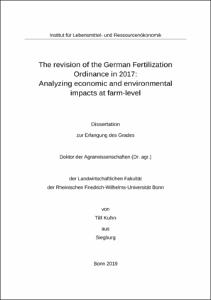Kuhn, Till: The revision of the German Fertilization Ordinance in 2017 : Analyzing economic and environmental impacts at farm-level. - Bonn, 2019. - Dissertation, Rheinische Friedrich-Wilhelms-Universität Bonn.
Online-Ausgabe in bonndoc: https://nbn-resolving.org/urn:nbn:de:hbz:5n-56008
Online-Ausgabe in bonndoc: https://nbn-resolving.org/urn:nbn:de:hbz:5n-56008
@phdthesis{handle:20.500.11811/8012,
urn: https://nbn-resolving.org/urn:nbn:de:hbz:5n-56008,
author = {{Till Kuhn}},
title = {The revision of the German Fertilization Ordinance in 2017 : Analyzing economic and environmental impacts at farm-level},
school = {Rheinische Friedrich-Wilhelms-Universität Bonn},
year = 2019,
month = oct,
note = {The Fertilization Ordinance (FO), implementing the EU Nitrates Directive in Germany, is the core regulation to limit the loss of reactive nitrogen and phosphorus from agriculture. It was revised in June 2017 after environmental targets have been missed. The revised FO contains considerable tighter measures such as stricter nutrient application thresholds and the mandatory use of low-emission manure application techniques. The aim of this thesis is to assess the economic and environmental impact of the revision at farm-level, focusing on Northwest Germany. To do so, a bio-economic farm model is applied to the pig fattening and dairy farm population of North Rhine-Westphalia and, in combination with a crop modelling framework, to dominant farm types selected from a generated typology. The model covers the measures of the FO as well as prominent compliance strategies. Manure transport as a central adaption strategy to meet stricter nutrient application thresholds is additionally evaluated in a life cycle assessment. On-farm compliance costs are highly heterogeneous and range from 0 to 2.66 Euro per pig for pig fattening farms and from 0 to 0.83 cent per kg milk for dairy farms. 47% of pig fattening and 38% of dairy farms do not face any costs. High compliance costs are found for pig fattening farms with high stocking densities, which need to fulfill the stricter phosphate surplus restrictions of the FO 2017. In contrast, dairy farms almost solely face costs for the compulsory use of low-emission manure application techniques. Intensive pig fattening farm types with a high stocking density reduce nitrate and ammonia losses considerably, which is mainly due to the export of excess manure, the shift of manure application from autumn to spring, and the use of low-emission manure application techniques. Less intensive pig fattening farm types, representing a high share of the pig stock, realize only little emission reduction. Arable farm types, starting to import manure under the FO 2017, can save variable costs by replacing chemical fertilizer. As a consequence, nitrate and ammonia losses increase, which illustrates the danger of regional pollution swapping due to manure imports. However, manure transport from livestock to arable farms can realize a net-reduction of all assessed environmental impacts. The heterogeneous impact of the FO 2017 makes it necessary to precisely target enforcement mechanisms as well as supporting measures at the affected farms. Furthermore, policymakers need to protect sensitive areas from the negative effect of manure imports.},
url = {https://hdl.handle.net/20.500.11811/8012}
}
urn: https://nbn-resolving.org/urn:nbn:de:hbz:5n-56008,
author = {{Till Kuhn}},
title = {The revision of the German Fertilization Ordinance in 2017 : Analyzing economic and environmental impacts at farm-level},
school = {Rheinische Friedrich-Wilhelms-Universität Bonn},
year = 2019,
month = oct,
note = {The Fertilization Ordinance (FO), implementing the EU Nitrates Directive in Germany, is the core regulation to limit the loss of reactive nitrogen and phosphorus from agriculture. It was revised in June 2017 after environmental targets have been missed. The revised FO contains considerable tighter measures such as stricter nutrient application thresholds and the mandatory use of low-emission manure application techniques. The aim of this thesis is to assess the economic and environmental impact of the revision at farm-level, focusing on Northwest Germany. To do so, a bio-economic farm model is applied to the pig fattening and dairy farm population of North Rhine-Westphalia and, in combination with a crop modelling framework, to dominant farm types selected from a generated typology. The model covers the measures of the FO as well as prominent compliance strategies. Manure transport as a central adaption strategy to meet stricter nutrient application thresholds is additionally evaluated in a life cycle assessment. On-farm compliance costs are highly heterogeneous and range from 0 to 2.66 Euro per pig for pig fattening farms and from 0 to 0.83 cent per kg milk for dairy farms. 47% of pig fattening and 38% of dairy farms do not face any costs. High compliance costs are found for pig fattening farms with high stocking densities, which need to fulfill the stricter phosphate surplus restrictions of the FO 2017. In contrast, dairy farms almost solely face costs for the compulsory use of low-emission manure application techniques. Intensive pig fattening farm types with a high stocking density reduce nitrate and ammonia losses considerably, which is mainly due to the export of excess manure, the shift of manure application from autumn to spring, and the use of low-emission manure application techniques. Less intensive pig fattening farm types, representing a high share of the pig stock, realize only little emission reduction. Arable farm types, starting to import manure under the FO 2017, can save variable costs by replacing chemical fertilizer. As a consequence, nitrate and ammonia losses increase, which illustrates the danger of regional pollution swapping due to manure imports. However, manure transport from livestock to arable farms can realize a net-reduction of all assessed environmental impacts. The heterogeneous impact of the FO 2017 makes it necessary to precisely target enforcement mechanisms as well as supporting measures at the affected farms. Furthermore, policymakers need to protect sensitive areas from the negative effect of manure imports.},
url = {https://hdl.handle.net/20.500.11811/8012}
}






